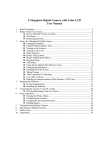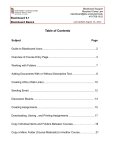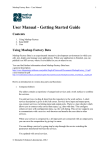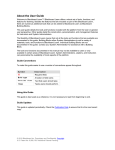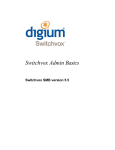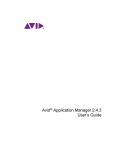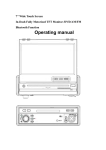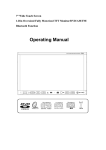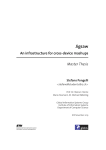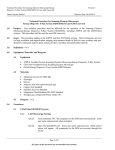Download Kerio Workspace User`s Guide
Transcript
Kerio Workspace Kerio Workspace User’s Guide Kerio Technologies 2012 Kerio Technologies s.r.o. Contents Creating spaces . . . . . . . . . . . . . . . . . . . . . . . . . . . . . . . . . . . . . . . . . . . . . . . . . . . . . . . . . . . . . . . . What is a space in Kerio Workspace . . . . . . . . . . . . . . . . . . . . . . . . . . . . . . . . . . . . . . . How to create a space . . . . . . . . . . . . . . . . . . . . . . . . . . . . . . . . . . . . . . . . . . . . . . . . . . . . . Additional space settings . . . . . . . . . . . . . . . . . . . . . . . . . . . . . . . . . . . . . . . . . . 5 5 5 5 How to create pages . . . . . . . . . . . . . . . . . . . . . . . . . . . . . . . . . . . . . . . . . . . . . . . . . . . . . . . . . . . What is a page in Kerio Workspace . . . . . . . . . . . . . . . . . . . . . . . . . . . . . . . . . . . . . . . . How to add a page . . . . . . . . . . . . . . . . . . . . . . . . . . . . . . . . . . . . . . . . . . . . . . . . . . . . . . . . Adding content to page . . . . . . . . . . . . . . . . . . . . . . . . . . . . . . . . . . . . . . . . . . . . Additional page properties . . . . . . . . . . . . . . . . . . . . . . . . . . . . . . . . . . . . . . . . . 6 6 6 6 6 Using components . . . . . . . . . . . . . . . . . . . . . . . . . . . . . . . . . . . . . . . . . . . . . . . . . . . . . . . . . . . . . What are components in Kerio Workspace . . . . . . . . . . . . . . . . . . . . . . . . . . . . . . . . . List of components and their functions . . . . . . . . . . . . . . . . . . . . . . . . . . . . . . . . . . . . Adding content to page . . . . . . . . . . . . . . . . . . . . . . . . . . . . . . . . . . . . . . . . . . . . Page content options . . . . . . . . . . . . . . . . . . . . . . . . . . . . . . . . . . . . . . . . . . . . . . . Examples of usage of selected components . . . . . . . . . . . . . . . . . . . . . . . . . . . . . . . . 7 7 7 7 8 9 Inserting calender events in pages . . . . . . . . . . . . . . . . . . . . . . . . . . . . . . . . . . . . . . . . . . . . 14 How to insert events in a page in Kerio Workspace . . . . . . . . . . . . . . . . . . . . . . . . 14 Additional options for Event list . . . . . . . . . . . . . . . . . . . . . . . . . . . . . . . . . . . . . . . . . . 14 Inserting files in pages . . . . . . . . . . . . . . . . . . . . . . . . . . . . . . . . . . . . . . . . . . . . . . . . . . . . . . . . 15 How to insert files in a page in Kerio Workspace . . . . . . . . . . . . . . . . . . . . . . . . . . 15 Additional options for File libraries . . . . . . . . . . . . . . . . . . . . . . . . . . . . . . . . . . . . . . . 15 Inserting images to pages . . . . . . . . . . . . . . . . . . . . . . . . . . . . . . . . . . . . . . . . . . . . . . . . . . . . . Inserting images in pages in Kerio Workspace . . . . . . . . . . . . . . . . . . . . . . . . . . . . . How to work with images . . . . . . . . . . . . . . . . . . . . . . . . . . . . . . . . . . . . . . . . . . . . . . . . Additional options for the Image component . . . . . . . . . . . . . . . . . . . . . . 16 16 17 17 Inserting videos in a page . . . . . . . . . . . . . . . . . . . . . . . . . . . . . . . . . . . . . . . . . . . . . . . . . . . . . 18 How to insert videos in a page in Kerio Workspace . . . . . . . . . . . . . . . . . . . . . . . . 18 Inserting external multimedia content in pages . . . . . . . . . . . . . . . . . . . . . . . . . . . . . . . . 19 How to insert external content in pages in Kerio Workspace . . . . . . . . . . . . . . . 19 3 Inserting link lists in pages . . . . . . . . . . . . . . . . . . . . . . . . . . . . . . . . . . . . . . . . . . . . . . . . . . . . 20 How to insert links in a page in Kerio Workspace . . . . . . . . . . . . . . . . . . . . . . . . . . 20 Additional options for Link list . . . . . . . . . . . . . . . . . . . . . . . . . . . . . . . . . . . . . . . . . . . 20 Inserting tasks in pages . . . . . . . . . . . . . . . . . . . . . . . . . . . . . . . . . . . . . . . . . . . . . . . . . . . . . . . 21 How to insert tasks in a page in Kerio Workspace . . . . . . . . . . . . . . . . . . . . . . . . . 21 Additional options for Task list . . . . . . . . . . . . . . . . . . . . . . . . . . . . . . . . . . . . . . . . . . 21 Sending information on changes and comments in your favorite pages . . . . . . . . 22 How to use News Feed and Favorites . . . . . . . . . . . . . . . . . . . . . . . . . . . . . . . . . . . . . 22 Sharing content with other users and groups . . . . . . . . . . . . . . . . . . . . . . . . . . . . . . . . . . Sharing content in Kerio Workspace . . . . . . . . . . . . . . . . . . . . . . . . . . . . . . . . . . . . . . Levels of access rights . . . . . . . . . . . . . . . . . . . . . . . . . . . . . . . . . . . . . . . . . . . . . . . . . . . How to change the access rights settings . . . . . . . . . . . . . . . . . . . . . . . . . . Additional inforamtion on sharing . . . . . . . . . . . . . . . . . . . . . . . . . . . . . . . . 23 23 23 23 24 Fulltext search in Kerio Workspace . . . . . . . . . . . . . . . . . . . . . . . . . . . . . . . . . . . . . . . . . . . . 25 how to search in Kerio Workspace . . . . . . . . . . . . . . . . . . . . . . . . . . . . . . . . . . . . . . . . 25 Drag and drop . . . . . . . . . . . . . . . . . . . . . . . . . . . . . . . . . . . . . . . . . . . . . . . . . . . . . . . . . . . . . . . . 26 When to use drag & drop in Kerio Workspace . . . . . . . . . . . . . . . . . . . . . . . . . . . . . 26 Synchronizing files using Kerio Workspace Client . . . . . . . . . . . . . . . . . . . . . . . . . . . . . How to install Kerio Workspace client . . . . . . . . . . . . . . . . . . . . . . . . . . . . . . . . . . . . How to downgrade Kerio Workspace client . . . . . . . . . . . . . . . . . . . . . . . . . . . . . . . . How to synchronize subscribed files with local store . . . . . . . . . . . . . . . . . . . . . . 4 27 27 27 28 Creating spaces What is a space in Kerio Workspace Spaces in Kerio Workspace are similar to folders. Spaces are used to: • hierarchize content, • sort information into logical units, • sharing larger amounts of related information. How to create a space Spaces can be added across hierarchy levels. There are two types of spaces: • If you wish to create a new space in the root folder, click on Create a New Space in the left bottom bar under the navigation tree. • Spaces can be nested without lilmits. If you wish to create a space within another space: • right-click on the parent space and select Create a New Space, • select the parent space and click on Create a New Space in the upper part of the content window. In the Create a New Space dialog, enter the name and description (for better reference, optional). Additional space settings When created projects in Kerio workspace, sharing can come in handy. For information on setting access rights to your content, read this article. 5 How to create pages What is a page in Kerio Workspace Pages in Kerio Workspace are used for creating and share of content, such as presentations, projects etc. How to add a page You can add pages to any space. Every page must be inserted in a space and cannot exist on its own. Go to a space where you wish to create a page and click on Create a New Page. You can also right-click a space name in the left-hand side and select the same option there. Enter a name of the page and select the Layout (one, two or three columns). You can change these parameters later. Adding content to page Empty page shows a list of components which you can insert. Components represent various types of content. They differ in type, format and the way you handle them. You can add additional content to a page by clicking on insert component which appears when you hover the mouse over the particular area. Select another component from the list. The Drag & Drop function is also available for inserting content (see this article). Additional page properties In section Layout you can change the number of page columns and their color as well as the color of the font. You can use your mouse to change the column width directly in your page. Often it is desirable to share the content in Kerio Workspace with your colleagues. information on setting access rights to your content, read this article. For To acquire a link to a page, click on Show Link — you can copy the link or send it by email (a simple dialog window is displayed). 6 Using components What are components in Kerio Workspace Components in Kerio Workspace enables you to create specific content. List of components and their functions To create content on a page, components are used. These components create specific content. Adding content to page Empty page shows a list of components which you can insert. Each component inserts a different type of content. They differ in type, format and the way you handle them. Click on a component name to open a detailed article: • Text — perfect component for text presentation with standard formatting options, it allows you to insert simple table • File library — enables uploads of files as attachments which can be downloaded, updated and previewed (available for some types) • Image — inserts image files into a page. Use your mouse to resize the image. • Link list — creates a list of links and helps to keep the page tidy. • Task list — creates tasks which can be marked as completed and shared with calendar applications via the ICS format • Event list — creates calendar events which can be shared with calendar applications via the ICS format • Mashup — displays an external content (usually a video file) on a page. The content is not saved to the Kerio Workspace store folder and thus saves space. The content is inserted with a special HTML code. • Video — allows you to upload video files to Kerio Workspace and displaying videos in the supported formats directly in the component window. It is recommended for sharing content which cannot be uploaded to external servers or inserted by the Mashup component You can add additional content to a page by clicking on insert component which appears when you hover the mouse over the particular area. Select another component from the list. 7 Using components The Drag & Drop function is also available for inserting content (see this article). Page content options Each component has their own options and settings, however, there are some which are common: • Drag & Drop — you can reorder the page content by grabbing the component (the icon with crossed arrows) and dragging it to another place on a page. Once you let go of the mouse button, the component is placed. • Resize — you can resize images, videos and mashups very easily. Hovering your mouse over the component will display a triangle in the bottom right corner. If you grab it with the mouse, you can change the size of the components. • Changing title — click on Rename to change the component’s title. • Common option in the context menu • Hide Title — the title of the component is not always convenient. • Background color — to make you pages more attractive, you can change the background color of each component. • Comment on This Component — commenting on a particular component may be useful on pages with a lot of content. If there are several components of the same type, it’s recommended to show their titles. • Cut This Component — components can be temporarily removed. When removed the components are displayed in the bottom right corner in the graphical clipboard which contains all removed (cut) components. These components can be inserted on a different page or returned to their original position. • Delete This Component — this options deletes the component. If you confirm the deletion, the component will be moved to section Deleted Items. In this section, you can undelete the component. • Comments — you can discuss the content at the bottom of the page. You can comment on individual components or individual changes. If you make any changes to any component, in the top right corner a yellow field appears where you can comment on your changes. If users mark any page as their Favorites, all comments on this page are displayed in their section News Feed (see this article on News Feed). 8 3.3 Examples of usage of selected components Examples of usage of selected components In the Fairy Wood Academy, a new term is being prepared. Lone Wolf, professor of Werewolfology, is no exception. For his two study groups, he is preparing a project called Werewolf. He wants to have all information in one place, so he creates a new page in Kerio Workspace which will contain all the materials, dates and will be available for discussion. Image He divides the page in three columns. In the top left corner, he places his profile to make the page more personal. This he performs using the Image component. Figure 1 Profile of professor Lone Wolf File Library Under his profile, he places a File library with the subject and lecture outlines. Students will be able to download them and use them for their study. Figure 2 Using a File library 9 Using components Simple list in text Dividing the student into groups using the bullets makes the student lists well arranged. Using a Text component, he inserts a direct link to the page with the project details. Figure 3 List of students contains bullets and text highlighting Highlighting within the text component The central column is used for large text. It contains information about the term project and instructions for students. Figure 4 Using colors to highlight texts 10 3.3 Examples of usage of selected components In the central column, professor Lone Wolf adds information about the criteria for successful completion of his course. Figure 5 Using paragraphs and highlighting in a text component Mashup In the top right corner, professor Wolf inserts a video describing sharing in Kerio Workspace. This may help students to cooperate on projects and during their study. Professor Wolf uses the Mashup component to display the video from an another web page. Figure 6 Using the Mashup component 11 Using components Using events for list of dates Dates of exams and deadlines for papers will be added to an Event list component which students can download to their calendar clients. No more excuses, dear students! Figure 7 Deadlines and dates in an Event list Tables in a text component Weekly schedule of lectures for the whole term can be converted to table. Figure 8 Using tables in a Text component Whole page Now, professor Lone Wolf is pleased. The whole page looks as follows: 12 3.3 Examples of usage of selected components Figure 9 Page with info on a term project in Werewolfology 13 Inserting calender events in pages How to insert events in a page in Kerio Workspace The Event list component allows to insert calendar events to a page: • In the component’s context menu, select Create New Event. • enter the name, start and end time (or check the All day option), location and notes. Save. The events in the list are sorted chronologically in the ascending order. The event info show the date, start and end time and length. Edit or remove the event via the right-hand arrow. Additional options for Event list Events can be edited or deleted. You can also download them in the ICS format and upload them in your calendar application. To export, click on Show Link in the context menu of the page. Click on Open next to the link in section Events and Tasks. The Open option exports all events and tasks in the page at once. Although it is not possible to export individual items, you can edit them in your calendar client. Other options available for events are common for all components. described in a separate article. 14 These settings are Inserting files in pages How to insert files in a page in Kerio Workspace The File library component allows you to insert any files by clicking on Upload New Files in the component’s context menu. Files can be uploaded by: • selecting files on your computer via the Upload New Files option and the standard system dialog, • selecting the files and using the drag and drop function to drag the files over the component. If you are satisfied, click the Upload button to add the files in the file library. In Google Chrome, you can upload even whole folders. Additional options for File libraries Individual files can be updated by uploading new versions, downloaded, or previewed (some formats). For each file, a specific link is available. Files can also be previewed and edited on your desktop. To do so, you have to install Kerio Workspace Client. Each file in the library has its own history which can be displayed and you can also download older version of any file or use links to those versions. You can create folders in the libraries. The files can be sorted in various orders. The file library supports the synchronization with your computer. Synchronized libraries are stored in a local folder Kerio Workspace on your computer in your user profile. Other options are common for all components. These settings are described in a separate article. 15 Inserting images to pages Inserting images in pages in Kerio Workspace The Image component allows you to insert images from your computer to any page: • by selecting in a standard system dialog, or • by dragging & dropping it in a page — drag the file over the insert component text Images are one of the components which are uploaded to the data store. Therefore it is necessary to make sure there is enough free space. Figure 1 An example of using images for academic purposes 16 6.2 How to work with images How to work with images I want to change the image size: the icon in the bottom right corner allows you to change the area size; the image The adjusts to the window in scale up to its original size. I want to upload a new version of an image • In the context menu of an image, select Upload New Image. • Drag & drop the file over the current image. Figure 2 Drag & drop function for uploading an image I want to save an image to my computer In the context menu of an image, select Download Image File. Additional options for the Image component Other options available for images are common for all components. described in a separate article. 17 These settings are Inserting videos in a page How to insert videos in a page in Kerio Workspace The video component allows you to insert video files in a page. Insert the video component in a place where you wish to display the video. Either click on Upload a video file or drag & drop a file (in FLV or F4V format) from your hard drive over this component. You can also use the Upload new video option from the context menu of the component which will replace the current video with a new one. User with corresponding access rights can download videos by clicking on Download video File in the context menu of the component. Multimedia files are usually large and occupy too much space on the server. If you wish to upload a file with less fragile information, it is convenient to use the Mashup component to display videos from an external web page. This component is convenient when uploading videos in an unsupported format. If it is not necessary to display the video in a page, you can use the File library component. 18 Inserting external multimedia content in pages How to insert external content in pages in Kerio Workspace Videos are large and saved in a different formats. Sometimes it is beneficial to insert such files form external source and thus save space on your server. That’s what the Mashup component is for. This component displays videos form the Internet in your page in Kerio Workspace without the need to upload the file to your server. The content is inserted via the HTML code which you enter after clicking on Enter a HTML code. The original page with the video should contain the code. For example, the popular multimedia server YouTube: 1. Click on Share (under the video). 2. Click on Embed. 3. In the dialog under the code, you can select various sizes and other parameters for the video. 4. Copy the code (CTRL+C). 5. Go back to your page in kerio Workspace. 6. Use CTRL+V to insert the code in Edit Mashup and save. Advanced users may change any parameters (for example, the size of the video). 19 Inserting link lists in pages How to insert links in a page in Kerio Workspace The Link list component enables users to insert links from the context menu: • In the component’s context menu, select Create New Link. • Enter a name and the URL including the protocol (HTTP, HTTPS), for example, http://www.fairywoodacademy.com. Save. Additional options for Link list You can edit or delete any link in the list. By using the Drag and drop, you can change the order of the links. Other options are common for all components. These settings are described in a separate article. 20 Inserting tasks in pages How to insert tasks in a page in Kerio Workspace The Task list component enables users to insert task from the context menu: • In the component’s context menu, select Create New Task. • Enter a name and set a due date and time if desirable. You can add some notes. • You can check tasks to mark that they have been completed. The task list is sorted by the insertion date. It displays the name of the task and the date for completion. If the task is marked as completed, the row is stroken through. The arrow on the right displays options for editing and removing. Additional options for Task list By using Drag and drop, you can change the order of the task in the lsit. You can also edit and remove them or download them in the ICS format and upload them in your calendar application. To export, click on Show Link in the context menu of the page. Click on Open next to the link in section Events and Tasks. The Open option exports all events and tasks in the page at once. Although it is not possible to export individual items, you can edit them in your calendar client. Other options are common for all components. These settings are described in a separate article. 21 Sending information on changes and comments in your favorite pages How to use News Feed and Favorites While collaborating on a project, it is difficult to monitor all changes to the pages and commentaries from other users. In Kerio Workspace, you can monitor your favorite content by using the Favorites and News Feed features. All spaces and pages which you mark as Favorite will display in a navigation tree on the left-hand side of the interface. All changes and comments to your favorite spaces and pages will be displayed on your welcome page in section News Feed. Use the Add to Favorites option (right-click in the left-hand side navigation tree or in the context menu of a page or a space) to add a space or a page to your favorites. You can also monitor changes and comments more comfortably. You can received them via email messages. 1. Click on your name in the top right corner. 2. Click on Settings. 3. Switch to the Notifications tab. 4. Check the Receive email notifications about updates in my favorite items option. You can disable this option any time as well as remove items from your Favorites. 22 Sharing content with other users and groups Sharing content in Kerio Workspace Kerio Workspace is a sophisticated platform for team work. To fulfill this role, it allows detailed settings of rights for accessing content in many layers. Spaces and pages can be shared with other users and groups. Access rights are inherited in a hierarchical manner, however, you can define specific rights for individual items. Levels of access rights The content author can assign access rights to their spaces and pages. Kerio Workspace has the following three levels of access rights: • Reader — users can view the content and add comments, • Contributor — users can edit the page or space content, • Admin — users can add, remove or edit access rights. If the access rights are not specified, users or groups cannot access the content. Access rights can be assigned to individual users or groups. Access rights assigned to a group are assigned to all users in the group. If a user has assigned access rights through both a group and individual settings, the individual settings are used. If a user with exclusive rights to some content is removed from Kerio Workspace, the administrator has to select another user who will inherit the user’s rights to access and manage the content. How to change the access rights settings To edit the access rights to pages and spaces, click on the icon in the top right corner. Click on Sharing. If the current page or space in the current hierarchy level inherits the access rights from the parent space, click on Edit Sharing Rights and choose whether to edit rights for the entire parent space or to create custom rights for the current space or page. You can add users and groups and assign or edit their access rights. Access rights can also be removed. If you wish to use the rights from the parent space, click on the corresponding button. 23 Sharing content with other users and groups Additional inforamtion on sharing Sharing is discussed in the our tutorial video. 24 Fulltext search in Kerio Workspace how to search in Kerio Workspace Kerio Workspace uses a special search engine for searching for content. In the Search field in the top bar, enter the text you wish to search for and confirm. The fulltext search supports the standard wildcard characters. Foe example, an asterisk (*) replaces any number of characters, a question mark (?) replaces one character. If you search for *ow, the results will include all occurances of crow, show, low, row, sparrow, throw, etc. If you search for ?ow, the results will include row. The results are sorted in order of relevance. You can search in all the spaces in Kerio Workspace or narrow your search to the current space (in all spaces and in space...). 25 Drag and drop When to use drag & drop in Kerio Workspace You can use the drag and drop functions: • To upload files by dragging files from your hard drive over the component. • To insert images and videos by dragging files from your hard drive over the component. • To change the page layout by dragging components to a different place. • To change the order of items in task lists. • To move pages and spaces in the navigation tree. 26 Synchronizing files using Kerio Workspace Client How to install Kerio Workspace client The installation package of Kerio Workspace Client can be accessed through the user interface of Kerio Workspace: 1. Click on your name in the top right corner. 2. Select the Tools option. 3. Download the installation file for your operating system. Figure 1 Options for downloading the installation file How to downgrade Kerio Workspace client If you wish to downgrade you Kerio Workspace Client, follow the instructions for your operating system: Windows If you are prompted to downgrade, download and run the installation package (see above). Mac OS X If you are pompted to downgrade, click on OK to run the terminal and use command sudo pkgutil --forget com.kerio.workspace.client.pkg Enter the admin password and install as usual (see above). 27 Synchronizing files using Kerio Workspace Client How to synchronize subscribed files with local store To login to Kerio Workspace Client, use the same username and password as for login to the Kerio Workspace user interface. Figure 2 Kerio Workspace Client login dialog To subscribe a file library for synchronization with your local store, open the component’s context menu and select Synchronize to My Computer File libraries are stored in folders which adopt the component’s name. On Windows, the files are stored in folder Kerio Workspace in your user profile on your computer. Figure 3 Synchronization option in File library context menu Synchronized file library is displayed as a folder in the Kerio Workspace Client application. To open it, click on the icon in the systray notification area. In the Kerio Workspace Client application, you can open file in the explorer„ in Kerio Workspace in your web browser or locally in an application associated with such types of files (text editor, PDF viewer, image editor etc.). 28 15.3 How to synchronize subscribed files with local store Figure 4 Preview in Kerio Workspace You can also unsubscribe File libraries from synchronization. The folder is then deleted from your local folder. Figure 5 File synchronization management window Majority of options is available through a right-click. 29 Figure 6 Options for synchronized folder 30































